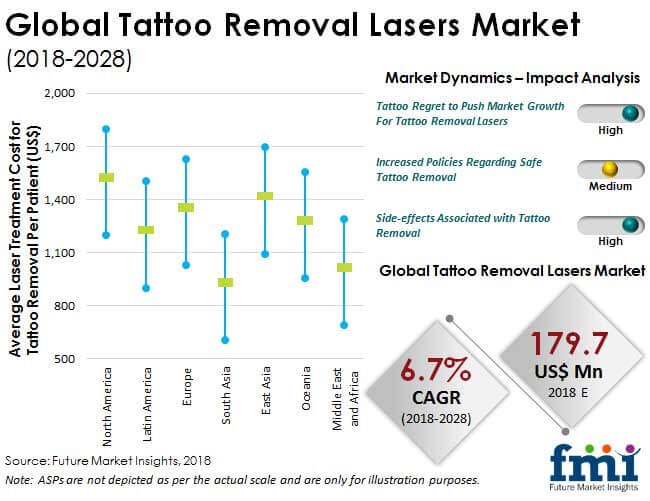
Tattoo Removal Lasers Market Growth, Outlook, Global Future Demand & Business Strategy By 2028
According to the latest research by Future Market Insights (FMI), the tattoo removal lasers market closed in on US$ 179 million in 2018. The revenue growth of tattoo removal lasers market has been estimated at a promising rate over the course of coming years. While over 7 in 10 patients prefer aesthetic clinics for the procedure of tattoo removal lasers, market value share of tattoo studios is likely to expand in coming years, as per FMI’s analysis.
Tattoo removal lasers have been incorporating the latest laser technologies specific to tattoo removal procedures. Constant developments in the tattoo removal lasers landscape, increase in product penetration across different regions, and increasing government support for R&D of innovative tattoo removal lasers will remain key demand determinants in tattoo removal lasers market.
Several new technologies have been contributing to the revenue growth of tattoo removal lasers market. However, picosecond tattoo removal lasers are extremely expensive. A combination of wavelengths has been in high demand for tattoo removal. For instance, according to a research study conducted on five patients by the Laser Health Academy, better clearance was achieved with a combination of 1,550 nm non-ablative fractional laser+YAG laser as compared to other tattoo removal lasers. The combination of YAG+YAG also resulted in shorter recovery time.
Request For Report Sample @ https://www.futuremarketinsights.com/reports/sample/rep-gb-2013
According to research studies conducted on tattoo removal lasers, a combination of QS Nd: YAG (1064 nm) and CO2 lasers for tattoo removal also resulted in a significantly high improvement on the combination side for Indian skin. Combination of tattoo removal techniques is being perceived as more effective than only Q-S tattoo removal lasers, as the former reduces the need for multiple sessions.
Moreover, combination tattoo removal lasers have not only reduced the number of sessions required, but also cut costs and reduced adverse effects such as hyper-pigmentation, long-going inflammatory responses, and bulla formation. Extensive research on the efficacy of these combination tattoo removal lasers are warranted, specifically considering the high patient demand for tattoo clearance. Thus, the high demand for combination tattoo removal lasers has consistently driven the tattoo removal lasers market.
 Tattoo Removal Lasers Market
Tattoo Removal Lasers MarketHowever, tattoo removal lasers work differently on different skin types, which may involve multiple adverse effects. Tattoo removal lasers that involve Q-switched also require eye protection for the prevention of retinal damage. Q-switched ruby tattoo removal lasers are linked with high clearance rates but are also contradictory because of the high incidence of prolonged hypopigmentation. Such adverse effects of tattoo removal lasers will remain are expected to hamper the growth of the tattoo removal lasers market during the forecast period.
The tattoo removal lasers market report tracks some of the key companies operating in the tattoo removal lasers market, which include Hologic Inc. (Cynosure), Shanghai Fosun Pharmaceutical(Group)Co., Ltd. (Alma Lasers), Cutera, Syneron® Medical Ltd., Fotona d.o.o., LUTRONIC, Lumenis, El.En. S.p.A. (Asclepion Laser Technologies GmbH), and Lynton Lasers.
Some of the commonplace complications that result post tattoo removal lasers treatment include prolonged erythema, hyperpigmentation, hypertrophic scar formation, and disseminated infection. On the other side, complications associated with fractional lasers include transient pigmentary changes, mild fibrosis, and hypopigmentation. Though most of the adverse effects associated with tattoo removal lasers can be cured within a short span of time, some of them may lead to serious complications in terms of skin texture and pigmentation.
Queries about Report, Speak To Analyst @ https://www.futuremarketinsights.com/ask-question/rep-gb-2013
Table of Content
- Executive Summary
1.1. Market Overview
1.2. Market Analysis
1.3. Market Trends
1.4. FMI Analysis and Recommendations
- Market Introduction
2.1. Market Introduction
2.2. Market Definition
2.3. Market Taxonomy
- Key Trends
3.1. Supply Trends
3.2. Demand Trends
- Tattoo Removal Lasers Market Analysis
4.1. Macro-Economic Factors
4.2. Opportunity Analysis
- Global Economic Outlook
5.1. Gross Domestic Product by Region & Country, 2006 – 2021
5.2. Global Healthcare Market Outlook
- Key Inclusions
6.1. Parent Market Assessment – 2017(A)
6.2. Tattoo Removal Lasers – Product Mapping
6.3. Volume(Units) Analysis, By Product Type, 2017
6.4. Average Laser Treatment Cost for Tattoo Removal Per Patient (US$), 2017
6.5. Tattoo Removal Lasers Market Regional Average Pricing Analysis, 2017
6.6. Global Tattoo Removal Lasers Market : Recent Developments
6.7. Medical Devices – Market Regulations
- Market Background
7.1. Market Dynamics
7.1.1. Drivers
7.1.2. Restraints
- Global Tattoo Removal Lasers Market Analysis 2013–2017 and Forecast 2018–2028, By Region
8.1. Introduction/Key Findings
8.2. Historical Market Value (US$ Mn) Analysis By Region, 2013–2017
8.3. Market Value (US$ Mn) Forecast By Region, 2018–2028
8.3.1. North America
8.3.2. Latin America
8.3.3. Europe
8.3.4. South Asia
8.3.5. East Asia
8.3.6. Oceania
8.3.7. Middle East & Africa
8.4. Market Attractiveness Analysis By Region
- Global Tattoo Removal Lasers Analysis 2013–2017 and Forecast 2018–2028, By Product Type
9.1. Introduction/Key Findings
9.2. Historical Market Value (US$ Mn) Analysis By Product Type, 2013–2017
9.2.1. Q-Switched Laser
9.2.1.1. Q-Switched Ruby Laser
9.2.1.2. Q-Switched Nd:YAG Laser
9.2.1.3. Q-Switched Alexandride Laser
9.2.2. Picosecond Laser
9.2.3. Combination Laser
The post Tattoo Removal Lasers Market Growth, Outlook, Global Future Demand & Business Strategy By 2028 first appeared on Market Research Blog.
Editor Details
-
Company:
- MARKITWIRED
- Website:
